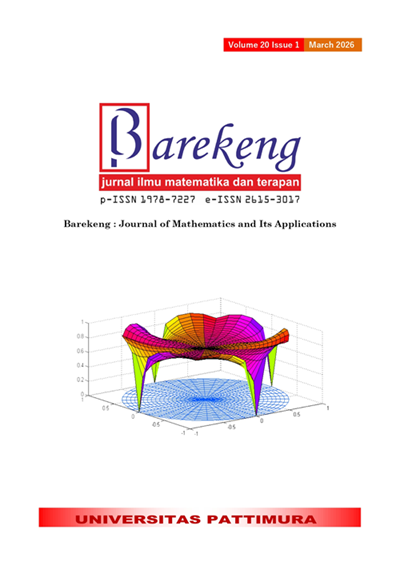COMPARATIVE STUDY OF LSTM-BASED MODELS WITH HYPERPARAMETER OPTIMIZATION FOR SHORT-TERM ELECTRICITY LOAD FORECASTING
Abstract
This research is focused on the development and comparison of time series models for short-term electrical load forecasting, utilizing several variants of Long Short-Term Memory (LSTM) networks. The specific LSTM variants employed in this study include Vanilla LSTM, Stacked LSTM, Bidirectional LSTM, and Convolutional Neural Network LSTM (CNN-LSTM). We used five years (2016-2020) of daily electricity load data from the Central Java-DIY system, provided by PT PLN (Persero). The primary objective is to ascertain the accuracy and evaluate the performance of these LSTM variants in the context of short-term load forecasting. This is achieved quantitatively through the computation of various error metrics, namely Mean Square Error (MSE), Mean Absolute Error (MAE), Root Mean Square Error (RMSE), Mean Absolute Percentage Error (MAPE), and R-squared. The results of the study reveal that the CNN-LSTM method outperforms the other variants in terms of the calculated metrics. Specifically, the CNN-LSTM method achieved the lowest values for all metrics: an MSE of 0.007 for training and 0.0010 for testing, an MAE of 0.0050 for training and 0.0062 for testing, and an RMSE of 0.083 for training and 0.099 for testing. Among the evaluated models, CNN-LSTM demonstrates the best trade-off between predictive accuracy and training efficiency, making it the most recommended for short-term electricity load forecasting. While BiLSTM achieves higher accuracy, particularly in terms of MAE, it requires a longer training time. In contrast, Stacked LSTM converges faster with slightly lower accuracy, making it a strong alternative when computational efficiency is prioritized..
Downloads
References
W. Holderbaum, F. Alasali, and A. Sinha, ENERGY FORECASTING AND CONTROL METHODS FOR ENERGY STORAGE SYSTEMS IN DISTRIBUTION NETWORKS, vol. 85. Cham, Switzerland: Springer, 2023. doi: https://doi.org/10.1007/978-3-030-82848-6.
I. K. Nti, M. Teimeh, O. Nyarko-Boateng, and A. F. Adekoya, “ELECTRICITY LOAD FORECASTING: A SYSTEMATIC REVIEW,” Journal of Electrical Systems and Information Technology, vol. 7, no. 1, pp. 1–19, Dec. 2020, doi: https://doi.org/10.1186/s43067-020-00021-8.
R. Chandrasekaran and S. K. Paramasivan, “ADVANCES IN DEEP LEARNING TECHNIQUES FOR SHORT-TERM ENERGY LOAD FORECASTING APPLICATIONS: A REVIEW,” Archives of Computational Methods in Engineering 2024, pp. 1–30, Jun. 2024, doi: https://doi.org/10.1007/s11831-024-10155-x.
Z. Guo, K. Zhou, X. Zhang, and S. Yang, “A DEEP LEARNING MODEL FOR SHORT-TERM POWER LOAD AND PROBABILITY DENSITY FORECASTING,” Energy, vol. 160, pp. 1186–1200, Oct. 2018, doi: https://doi.org/10.1016/j.energy.2018.07.090.
C. Tian, J. Ma, C. Zhang, and P. Zhan, “A DEEP NEURAL NETWORK MODEL FOR SHORT-TERM LOAD FORECAST BASED ON LONG SHORT-TERM MEMORY NETWORK AND CONVOLUTIONAL NEURAL NETWORK,” Energies (Basel), vol. 11, no. 12, p. 3493, Dec. 2018, doi: https://doi.org/10.3390/en11123493.
P. H. Kuo and C. J. Huang, “A HIGH PRECISION ARTIFICIAL NEURAL NETWORKS MODEL FOR SHORT-TERM ENERGY LOAD FORECASTING,” Energies 2018, Vol. 11, Page 213, vol. 11, no. 1, p. 213, Jan. 2018, doi: https://doi.org/10.3390/en11010213.
J. Zheng, X. Chen, K. Yu, L. Gan, Y. Wang, and K. Wang, “SHORT-TERM POWER LOAD FORECASTING OF RESIDENTIAL COMMUNITY BASED ON GRU NEURAL NETWORK,” 2018 International Conference on Power System Technology, POWERCON 2018 - Proceedings, pp. 4862–4868, Jul. 2018, doi: https://doi.org/10.1109/POWERCON.2018.8601718.
H. Choi, S. Ryu, and H. Kim, “SHORT-TERM LOAD FORECASTING BASED ON RESNET AND LSTM,” 2018 IEEE International Conference on Communications, Control, and Computing Technologies for Smart Grids, SmartGridComm 2018, Dec. 2018, doi: https://doi.org/10.1109/SmartGridComm.2018.8587554.
G. M. U. Din and A. K. Marnerides, “SHORT TERM POWER LOAD FORECASTING USING DEEP NEURAL NETWORKS,” 2017 INTERNATIONAL CONFERENCE ON COMPUTING, NETWORKING AND COMMUNICATIONS, ICNC 2017, pp. 594–598, Mar. 2017, doi: 1 https://doi.org/10.1109/ICCNC.2017.7876196
N. A. Nguyen, T. D. Dang, E. Verdú, and V. Kumar Solanki, “SHORT-TERM FORECASTING ELECTRICITY LOAD BY LONG SHORT-TERM MEMORY AND REINFORCEMENT LEARNING FOR OPTIMIZATION OF HYPER-PARAMETERS,” Evol Intell, vol. 16, no. 5, pp. 1729–1746, Oct. 2023, doi: https://doi.org/10.1007/s12065-023-00869-5.
E. Uwimana, Y. Zhou, and N. M. Sall, “A SHORT-TERM LOAD DEMAND FORECASTING: LEVENBERG–MARQUARDT (LM), BAYESIAN REGULARIZATION (BR), AND SCALED CONJUGATE GRADIENT (SCG) OPTIMIZATION ALGORITHM ANALYSIS,” Journal of Supercomputing, vol. 81, no. 1, pp. 1–30, Jan. 2025, doi: https://doi.org/10.1007/s11227-024-06513-y
J. Luo, Y. Zheng, T. Hong, A. Luo, and X. Yang, “FUZZY SUPPORT VECTOR REGRESSIONS FOR SHORT-TERM LOAD FORECASTING,” Fuzzy Optimization and Decision Making, vol. 23, no. 3, pp. 363–385, Sep. 2024, doi: https://doi.org/10.1007/s10700-024-09425-x.
Y. Xie et al., “SHORT-TERM LOAD FORECASTING METHOD BASED ON FUZZY OPTIMIZATION COMBINED MODEL OF LOAD FEATURE RECOGNITION,” Electrical Engineering, pp. 1–14, Jun. 2024, doi: https://doi.org/10.21203/rs.3.rs-3836587/v1.
Nirwanto, S. Bahri, and L. Harsyiah, “COMPARATIVE ANALYSIS OF FUZZY TIME SERIES CHEN AND MARKOV CHAIN METHODS FOR FORECASTING ELECTRICITY CONSUMPTION IN MATARAM CITY,” BAREKENG: Jurnal Ilmu Matematika dan Terapan, vol. 18, no. 4, pp. 2375–2386, Oct. 2024, doi: https://doi.org/10.30598/barekengvol18iss4pp2375-2386.
S. Bahrami, R. A. Hooshmand, and M. Parastegari, “SHORT TERM ELECTRIC LOAD FORECASTING BY WAVELET TRANSFORM AND GREY MODEL IMPROVED BY PSO (PARTICLE SWARM OPTIMIZATION) ALGORITHM,” Energy, vol. 72, pp. 434–442, Aug. 2014, doi: https://doi.org/10.1016/j.energy.2014.05.065.
M. Djukanovic, S. Ruzic, B. Babic, D. J. Sobajic, and Y. H. Pao, “A NEURAL-NET BASED SHORT TERM LOAD FORECASTING USING MOVING WINDOW PROCEDURE,” International Journal of Electrical Power & Energy Systems, vol. 17, no. 6, pp. 391–397, Dec. 1995, doi: https://doi.org/10.1016/0142-0615(94)00009-3
P. J. Santos, A. G. Martins, and A. J. Pires, “DESIGNING THE INPUT VECTOR TO ANN-BASED MODELS FOR SHORT-TERM LOAD FORECAST IN ELECTRICITY DISTRIBUTION SYSTEMS,” International Journal of Electrical Power & Energy Systems, vol. 29, no. 4, pp. 338–347, May 2007, doi: https://doi.org/10.1016/j.ijepes.2006.09.002.
G. Sudheer and A. Suseelatha, “SHORT TERM LOAD FORECASTING USING WAVELET TRANSFORM COMBINED WITH HOLT–WINTERS AND WEIGHTED NEAREST NEIGHBOR MODELS,” International Journal of Electrical Power & Energy Systems, vol. 64, pp. 340–346, Jan. 2015, doi: https://doi.org/10.1016/j.ijepes.2014.07.043.
J. Wang, J. Gao, and D. Wei, “ELECTRIC LOAD PREDICTION BASED ON A NOVEL COMBINED INTERVAL FORECASTING SYSTEM,” Appl Energy, vol. 322, p. 119420, Sep. 2022, doi: https://doi.org/10.1016/j.apenergy.2022.119420.
A. Haque and S. Rahman, “SHORT-TERM ELECTRICAL LOAD FORECASTING THROUGH HEURISTIC CONFIGURATION OF REGULARIZED DEEP NEURAL NETWORK,” Appl Soft Comput, vol. 122, p. 108877, Jun. 2022, doi: https://doi.org/10.1016/j.asoc.2022.108877.
I. Yazici, O. F. Beyca, and D. Delen, “DEEP-LEARNING-BASED SHORT-TERM ELECTRICITY LOAD FORECASTING: A REAL CASE APPLICATION,” Eng Appl Artif Intell, vol. 109, p. 104645, Mar. 2022, doi: https://doi.org/10.1016/j.engappai.2021.104645.
X. Wen, J. Liao, Q. Niu, N. Shen, and Y. Bao, “DEEP LEARNING-DRIVEN HYBRID MODEL FOR SHORT-TERM LOAD FORECASTING AND SMART GRID INFORMATION MANAGEMENT,” Sci Rep, vol. 14, no. 1, pp. 1–16, Dec. 2024, doi: https://doi.org/10.1038/s41598-024-63262-x.
J. Bedi and D. Toshniwal, “DEEP LEARNING FRAMEWORK TO FORECAST ELECTRICITY DEMAND,” Appl Energy, vol. 238, pp. 1312–1326, Mar. 2019, doi: https://doi.org/10.1016/j.apenergy.2019.01.113.
E. Mora, J. Cifuentes, and G. Marulanda, “SHORT-TERM FORECASTING OF WIND ENERGY: A COMPARISON OF DEEP LEARNING FRAMEWORKS,” Energies (Basel), vol. 14, no. 23, p. 7943, Dec. 2021, doi: https://doi.org/10.3390/en14237943.
I. Goodfellow, DEEP LEARNING. MIT Press, 2016.
A. Graves, A. Mohamed, and G. Hinton, “SPEECH RECOGNITION WITH DEEP RECURRENT NEURAL NETWORKS,” in 2013 IEEE international conference on acoustics, speech and signal processing, 2013, pp. 6645–6649.doi: https://doi.org/10.1109/ICASSP.2013.6638947
“1997 - SEPP HOCHREITER DAN JÜRGEN SCHMIDHUBER - LSTM”.
C. Li et al., “LONG SHORT-TERM MEMORY NETWORKS IN MEMRISTOR CROSSBAR ARRAYS,” Nat Mach Intell, vol. 1, no. 1, pp. 49–57, 2019.doi: https://doi.org/10.1038/s42256-018-0001-4
S. Hochreiter, “LONG SHORT-TERM MEMORY,” Neural Computation MIT-Press, 1997.doi: https://doi.org/10.1162/neco.1997.9.8.1735
I. Rivaldi Siregar et al., “THE COMPARISON OF LONG SHORT-TERM MEMORY AND BIDIRECTIONAL LONG SHORT-TERM MEMORY FOR FORECASTING COAL PRICE,” BAREKENG: Jurnal Ilmu Matematika dan Terapan, vol. 19, no. 1, pp. 245–258, Jan. 2025, doi: https://doi.org/10.30598/barekengvol19iss1pp245-258
C. Cai, Y. Tao, T. Zhu, and Z. Deng, “SHORT-TERM LOAD FORECASTING BASED ON DEEP LEARNING BIDIRECTIONAL LSTM NEURAL NETWORK,” Applied Sciences, vol. 11, no. 17, p. 8129, 2021.doi: https://doi.org/10.3390/app11178129
X. Shi, Z. Chen, H. Wang, D.-Y. Yeung, W.-K. Wong, and W. Woo, “CONVOLUTIONAL LSTM NETWORK: A MACHINE LEARNING APPROACH FOR PRECIPITATION NOWCASTING,” Adv Neural Inf Process Syst, vol. 28, 2015.
F. M. Butt et al., “OPTIMIZING PARAMETERS OF ARTIFICIAL INTELLIGENCE DEEP CONVOLUTIONAL NEURAL NETWORKS (CNN) TO IMPROVE PREDICTION PERFORMANCE OF LOAD FORECASTING SYSTEM,” in IOP conference series: earth and environmental science, 2022, p. 12028.doi: https://doi.org/10.1088/1755-1315/1026/1/012028
J. Gu et al., “RECENT ADVANCES IN CONVOLUTIONAL NEURAL NETWORKS,” Pattern Recognit, vol. 77, pp. 354–377, 2018.doi: https://doi.org/10.1016/j.patcog.2017.10.013
Copyright (c) 2025 Iqbal Kharisudin, Insyiraah Oxaichiko Arissinta, Sabrina Aziz Aulia, Muhamad Abdul Qodir Dani, Galih Kusuma Wijaya

This work is licensed under a Creative Commons Attribution-ShareAlike 4.0 International License.
Authors who publish with this Journal agree to the following terms:
- Author retain copyright and grant the journal right of first publication with the work simultaneously licensed under a creative commons attribution license that allow others to share the work within an acknowledgement of the work’s authorship and initial publication of this journal.
- Authors are able to enter into separate, additional contractual arrangement for the non-exclusive distribution of the journal’s published version of the work (e.g. acknowledgement of its initial publication in this journal).
- Authors are permitted and encouraged to post their work online (e.g. in institutional repositories or on their websites) prior to and during the submission process, as it can lead to productive exchanges, as well as earlier and greater citation of published works.






1.gif)



